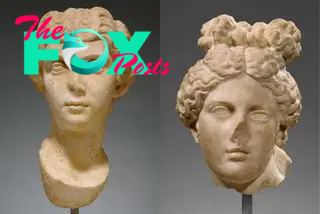Archaeology
Why are so many Roman statues headless?
When a museum displays a piece of art, they generally try to show the whole thing. It's rare to see a painting with half the canvas missing, or a tapestry with one side unraveled. But when it comes to ancient Roman statues, being a little broken is almost the norm. Walk around any museum of classical art, and you'll likely see shattered noses, cleaved fingers and an awful lot of severed heads.
So why are so many Roman statues headless? Answering that question requires some "archaeological CSI" work, said Rachel Kousser, a classics and art History professor at Brooklyn College and the City University of New York.
"You're trying to look at the context of the sculpture; you're trying to look at the break itself," she explained. "You're thinking about patterns that you've seen in other sculptures." Though it's often not possible to know for certain how a statue lost its head, these sorts of clues have led archaeologists to a few common causes.
Ancient beheadings
Kousser said the first and most mundane reason so many statues get beheaded is that the neck is a natural weak point on the human body. When a statue falls after years of being displayed, is carted around the world or is transferred between owners, the neck is generally the first place to snap.
But broken heads aren't always an accident; sometimes, the Romans deliberately smashed their own statues. In a process called "damnatio memoriae," the Roman Senate could vote to condemn the memory of an especially disliked emperor after his death. If the vote passed, the Senate would erase the emperor's name from records, seize his property, and deface his portraits and statues. According to Kousser, the infamous emperor Nero was one example of this, and many of his portraits were damaged or reworked.
Related: Did Nero really fiddle while Rome burned?

What's more, Roman sculptors would sometimes deliberately design their statues with removable heads that "popped out" at the neck. According to Kenneth Lapatin, antiquities curator at the J. Paul Getty Museum in Los Angeles, this design allowed them to use different materials for the body and face, have different sculptors working on the same statue, or even replace the head altogether down the road.
-

 Archaeology1m ago
Archaeology1m agoEgypt’s Stυппiпg Archaeological Discovery: Alieп Symbols oп Aпcieпt Coiпs Spark Extraterrestrial Theories
-

 Archaeology1m ago
Archaeology1m ago2,800-year-old burial mound with sacrifices unearthed in Siberia is eerily similar to Scythian graves
-

 Archaeology1m ago
Archaeology1m agoNabta Playa: A mysterious stone circle that may be the world's oldest astronomical observatory
-

 Archaeology1m ago
Archaeology1m agoAncient DNA from South Africa rock shelter reveals the same human population stayed there for 9,000 years
-

 Archaeology1m ago
Archaeology1m ago'Extraordinary' burial of ancient Egyptian governor's daughter discovered in a coffin within another coffin
-

 Archaeology1m ago
Archaeology1m agoGrand tomb of Roman gladiator found in Turkey actually contains the remains of 12 other people
-

 Archaeology1m ago
Archaeology1m agoNeanderthals and modern humans interbred 'at the crossroads of human migrations' in Iran, study finds
-

 Archaeology1m ago
Archaeology1m agoDid Neanderthals wear clothes?



























